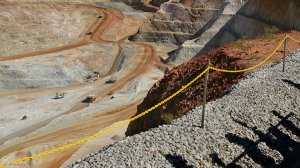Oz gold production drops in March quarter – Surbiton
PERTH (miningweekly.com) – Australian gold production declined by 6 t, or about 7%, in the three months to March, compared with the previous period, reaching some 74 t, gold mining consultants Surbiton Association reported.
Surbiton director Dr Sandra Close noted that despite the lower March quarter output, the results compared favourably with the 71 t produced in the previous corresponding period.
“Overall, it was a reasonable performance given that production in the December quarter was particularly high at 80 t,” said Close.
“This was an outstanding result; however, as anticipated, the figures for the latest quarter are down, as the usual wet weather early in the year in Western Australia and north Queensland caused production cuts at several mines.”
“Just a handful of the largest operations accounted for some 4 t less gold production in the March quarter. When wet conditions cause mining and haulage problems, operators have to draw from low grade stockpiles to maintain mill throughput.”
She said that in the latest quarter, AngloGold and Independence Group’s Tropicana joint venture produced 34 000 oz less, Newcrest’s Telfer operations output was down 33 000 oz, Newmont and Barrick’s Super Pit was 28 000 oz lower and output from Newmont’s Boddington and Tanami operations fell by a combined 30 000 oz.
“In addition, Newcrest’s Cadia East operation in New South Wales was down some 37 000 oz in the March quarter. It has had a difficult time in the last 12 months but now production has resumed once more and gold and copper output is improving.”
In mid-July 2017, Cadia East suffered an earth tremor which disrupted production during the September quarter. Although production recovered in the December quarter, it was disrupted again when a tailings dam wall was breached in March 2018. Mining was suspended for two weeks and processing did not resume for a further week.
“Only a small number of operations reported higher output during the March quarter. AngloGold’s Sunrise Dam operation increased output by about 20 000 oz mainly due to higher recovered ore grade from underground, while both BHP’s Olympic Dam and Silver Lake’s Mt Monger operations each produced 13 000 oz more.”
Close said overseas control of Australia’s gold production has progressively fallen for some years and will likely continue to decline as Australian companies develop new mines and some overseas companies withdraw, often selling their Australian operations back to local producers.
“Overseas control of Australia’s gold mines rose from around 20% to around 70% in the late 1990s and early 2000s. But it has subsequently reduced substantially, so that overseas control currently sits at around 46%,” Close said.
She added that it was disappointing to hear that once again the subject of an increased royalty on gold had been raised in Western Australia, where about three-quarters of Australia’s gold is produced. Although the royalty was not increased in the Western Australia State Budget on May 10, Treasurer Ben Wyatt said he believed that an increase in the royalty for gold was justified, noting that its royalty rate was lower than that charged for other minerals.
“Not all commodities are the same and the royalty rate applying to one mineral may not be appropriate for another. For example, iron-ore is a bulk commodity that lends itself to large-scale mining and minimal upgrading. Gold is at the other end of the spectrum, with very low grade ore mined on a much smaller scale, with that ore also requiring significant processing and refining.”
Close said that at any particular time there were always some operations doing well, some operations will be just profitable and some will be really struggling.
“Overall the gold mining sector works hard to control costs but currently some producers have all-in sustaining costs well above the gold price. To impose a higher royalty would seem a peculiar way for the present Western Australian government to keep people in work and to keep the gold industry productive and contributing to our export earnings.”
Comments
Press Office
Announcements
What's On
Subscribe to improve your user experience...
Option 1 (equivalent of R125 a month):
Receive a weekly copy of Creamer Media's Engineering News & Mining Weekly magazine
(print copy for those in South Africa and e-magazine for those outside of South Africa)
Receive daily email newsletters
Access to full search results
Access archive of magazine back copies
Access to Projects in Progress
Access to ONE Research Report of your choice in PDF format
Option 2 (equivalent of R375 a month):
All benefits from Option 1
PLUS
Access to Creamer Media's Research Channel Africa for ALL Research Reports, in PDF format, on various industrial and mining sectors
including Electricity; Water; Energy Transition; Hydrogen; Roads, Rail and Ports; Coal; Gold; Platinum; Battery Metals; etc.
Already a subscriber?
Forgotten your password?
Receive weekly copy of Creamer Media's Engineering News & Mining Weekly magazine (print copy for those in South Africa and e-magazine for those outside of South Africa)
➕
Recieve daily email newsletters
➕
Access to full search results
➕
Access archive of magazine back copies
➕
Access to Projects in Progress
➕
Access to ONE Research Report of your choice in PDF format
RESEARCH CHANNEL AFRICA
R4500 (equivalent of R375 a month)
SUBSCRIBEAll benefits from Option 1
➕
Access to Creamer Media's Research Channel Africa for ALL Research Reports on various industrial and mining sectors, in PDF format, including on:
Electricity
➕
Water
➕
Energy Transition
➕
Hydrogen
➕
Roads, Rail and Ports
➕
Coal
➕
Gold
➕
Platinum
➕
Battery Metals
➕
etc.
Receive all benefits from Option 1 or Option 2 delivered to numerous people at your company
➕
Multiple User names and Passwords for simultaneous log-ins
➕
Intranet integration access to all in your organisation





















